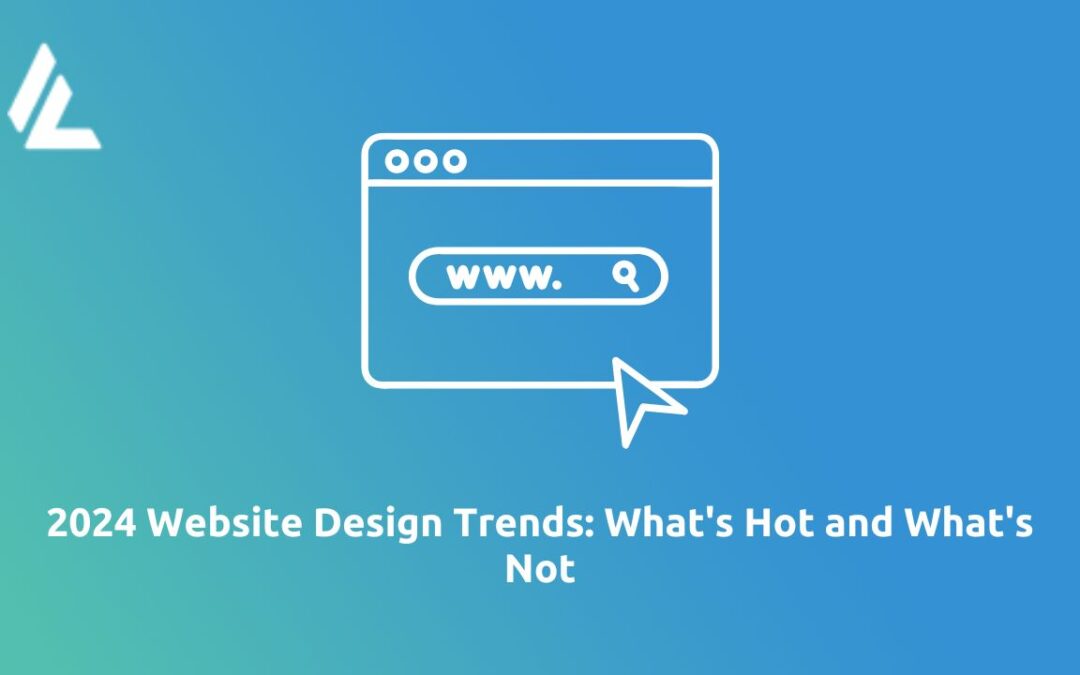Table of Contents
The field of digital design is always changing in the fast-paced digital world of today. It is essential to get ahead of the curve and predict the upcoming wave of trends and developments if you want to genuinely grab users’ attention and interest. As we begin 2024, website design trends is going through a dynamic evolution that is marked by a wide range of new trends and timeless design concepts. The world of website design is a mashup of innovation and tradition, ranging from ground-breaking methods that push the bounds of creativity to classic design ideas that endure.
We’ll take a tour of the newest and most significant website design trends that are influencing the digital landscape in 2024 with this in-depth guide. We will examine the major advancements that are propelling the growth of website design in the digital realm, from cutting-edge technologies to sophisticated aesthetics. Furthermore, we’ll draw attention to methods that might be becoming less useful or relevant in the rapidly evolving digital environment.
This book is your compass in navigating the fascinating and dynamic world of website design trends for 2024, whether you’re a business owner looking to revive your online presence or an experienced web designer looking to stay up to date on the newest industry trends. So buckle in and get ready for an exciting adventure through the dynamic field of digital design, where creativity is unrestricted and innovation blends with tradition.
1.Responsive Web Design Trends:
In the mobile-first world of today, responsive web design still holds a dominant position. Websites that are responsive to different screen sizes, resolutions, and devices are now required, not just nice to have. By 2024, designers will be putting more emphasis on mobile-first experiences than ever before, giving top priority to touch-friendly navigation, fluid layouts, and adaptive visuals. Adopting responsive design is a timeless trend that will last because it improves search engine rankings in addition to improving user experience.
2. Dark Mode: Setting the Stage for Sleek and Stylish Designs:
Once thought to be unique, dark mode has become a popular website design trends, drawing visitors in with its sleek, contemporary look. Dark mode provides a welcome change from conventional light-themed interfaces, especially given the increasing popularity of OLED screens and the increased emphasis on minimizing eye strain. Anticipate seeing more dark user interface (UI) components on websites in 2024, ranging from colorful accents to minimalist layouts, as designers take use of dark UI’s energy-saving properties and aesthetic appeal.
3. Immersive Experiences: Elevating Engagement with 3D Graphics and Animation:
Website designers are adopting immersive experiences to capture audiences as attention spans get shorter and competition for user engagement gets fiercer. Websites with captivating 3D animations, dynamic effects, and images that conflate virtual and real worlds are what to anticipate in 2024. Interactive storytelling and user journeys that are memorable are replacing the days of passive browsing, whether it’s through scroll-triggered animations, parallax scrolling, or WebGL-powered visualizations.
4. Minimalist Design: Embracing Simplicity in a Cluttered Digital Landscape:
Minimalist design is a breath of fresh air in an era where people are overloaded with information and pictures. It provides a break from cluttered interfaces and overpowering visuals. The minimalist style is still popular in 2024, with designers emphasizing clear navigation, spacious layouts, and lots of white space. Minimalist websites communicate elegance, refinement, and clarity by eliminating extraneous components and emphasizing important material. This appeals to visitors who are looking for simplicity amid the chaos of the digital world.

5. Voice User Interface (VUI) Design: Redefining Interaction Paradigms:
Voice user interface (VUI) design is transforming how we engage with websites and digital platforms in light of the growing popularity of virtual assistants and smart speakers. Anticipate a rise in VUI-driven experiences in 2024, wherein users can utilize natural language commands to navigate websites, execute tasks, and retrieve information. Voice search integration and conversational interfaces are only two examples of how VUI design improves accessibility, encourages connection, and meets the growing need for hands-free interaction in a connected world.
6. Sustainability in Design: Pioneering Eco-Friendly Digital Practices:
Designing with sustainability in mind becomes increasingly important for the digital community as environmental awareness becomes more and more integrated into our daily lives. Anticipate a movement in online design towards eco-friendly methods in 2024, with designers giving resource conservation, carbon neutrality, and energy efficiency a top priority. Through carbon emission reduction and website performance optimization, sustainable design not only lessens its negative effects on the environment but also improves brand reputation and encourages social responsibility in users.
7. Augmented Reality (AR) Integration: Enhancing Real-World Engagement:
The integration of augmented reality (AR) is transforming how people engage with digital material and reducing the boundaries between the real and virtual worlds. Anticipate a spike in websites with augmented reality (AR) components in 2024, ranging from interactive product demos to fully immersive storytelling experiences. Through the use of AR technology, designers can produce engaging and memorable user experiences that increase online interactions, encourage brand loyalty, and boost engagement.
8. Data-Driven Design: Personalizing User Experiences for Optimal Engagement:
Using analytics and user insights is essential for developing individualized and memorable online experiences in the era of big data. By 2024, data-driven design will be the main trend, with designers using AI and machine learning to customize functionality, layout, and content according to the tastes and actions of specific users. In an increasingly competitive digital world, data-driven design not only improves user engagement but also boosts conversions, retention, and brand advocacy by providing relevant and contextually rich experiences.
Conclusion:
Website design trends is changing quickly as we bid adieu to the styles of the past and welcome the opportunities of the future. The trends reshaping the digital scene in 2024 show a dynamic interplay of innovation, functionality, and aesthetics, ranging from adaptable design to immersive experiences. Businesses and designers can produce engaging online experiences that connect with audiences, encourage participation, and endure in the ever-changing digital marketing landscape by keeping an eye on these new trends and embracing progressive design principles.

